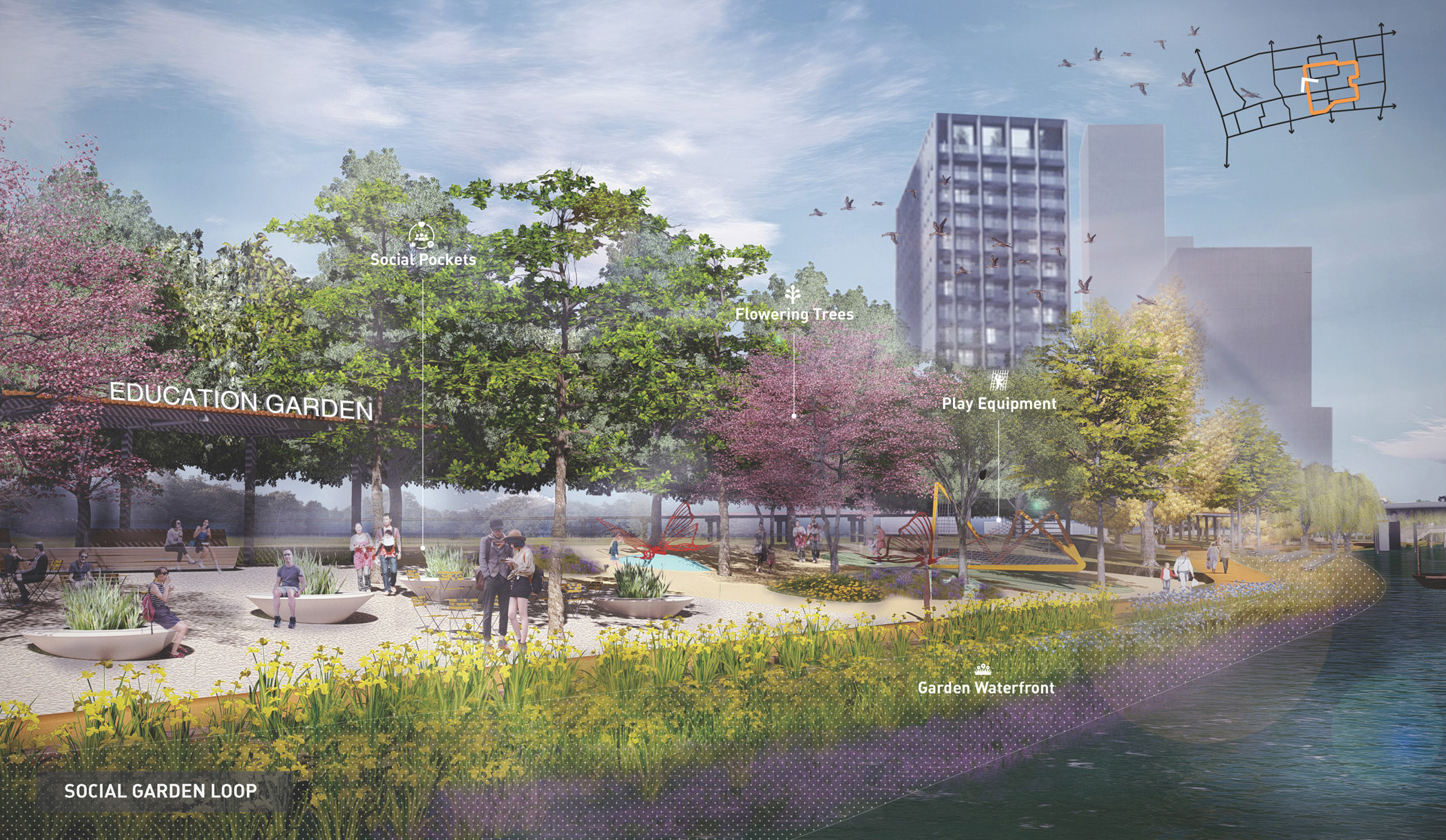Hangzhou Bay New Town — A Canal Connected City
May 25th, 2021
Hangzhou Bay, China

Hangzhou Bay New Town District provides the unique opportunity to be at the forefront of sustainable urban development—shaping city blocks, open space, transit and bicycle networks—to restore the region's waterways. Working across scales, the design integrates canal and dike infrastructure into public space to make the district's waterfronts accessible and vibrant places.


CONTEXT
Hangzhou Bay New Town is a 23.5 square kilometer waterfront district in a largely unbuilt coastal area north of Ningbo, China. Located at the nexus of major metropoli, the District sits poised to attract businesses and residents from Shanghai, Suzhou, Hangzhou and Ningbo. With direct highway routes to surrounding cities, the area is undergoing heavy development and an influx of residents.

Life in this region has traditionally revolved around the use of water and manipulation of the shoreline. From 1040 CE until today, the area was built up using a comprehensive dike system that provided the opportunity for salt ponds, agriculture, and fishing industries to thrive. Today, site challenges include road and bridge infrastructure, disconnected routes, hard edged canals, poor water quality, historic dikes, and scattered empty parcels.


The entire Hangzhou Bay Area is slated for development, and within that space, the team has created plans for the Hangzhou Bay New Town [HBNT]. This scope encompasses a detailed design area, the 42 hectares of waterfront in the HBNT South District.

Reinvigorating the relationship between people and water, Hangzhou Bay New Town masterplan envisions sustainable development with historic and hydrologic concerns integrating with an innovative new district. The plan's canal framework sets the stage for new residents to connect with Hangzhou Bay Area's history and each other. Utilizing three primary strategies of 1) Connection 2) Engagement and 3) Ecology, the masterplan proposes a district that reconnects people to the water across scales.


CONNECTION
Confronting existing site challenges, the design team sought connection and rehabilitation with canals creating a continuous waterfront experience. In order to connect waterfronts throughout the New Town District, the pathway experience and crossing infrastructure become vital. Pedestrian walkways become bridges at canals, entry plazas at roads, and plazas are integrated into the right of way with intersection corner plazas.
 VIBRANCY
VIBRANCY Drawing from the site's history, geology and culture, the thread becomes people's ongoing relationship with water and the systems channelling and controlling it. Nodes celebrate historical waterfront culture while introducing programmatic elements to activate corridors and network nodes alike. This overlay of ecology, pedestrian routes and exciting nodes sets the stage for an urban framework formed from landscape architecture principles.
 SUSTAINABILITY
SUSTAINABILITYConnecting degraded canals to one another will improve hydrology, with increased flow counteracting stagnant conditions. Transforming canals from hard edged and exposed into wetlands will clean the water and provide essential habitat for local species. These waterfronts are complemented by green roofs, permeable paving, bamboo decks, and street trees selected for their low biogenic emissions.

DISTRICT LANDSCAPE FRAMEWORK
Using Connection, Engagement and Sustainability as the basis for all decisions, the HBNT South District framework was built up in more detail to meet those goals. First linking to nearby areas, then establishing an internal logic. Consisting of two river corridors and two waterfront loops, the framework coincides with the district's North-South central core.
Running East-West, Jiutang means "Ninth dike" which formed the shoreline in 1960. This historic structure—which has previously acted as a barrier—is being restored, repurposed and renewed to contribute to the spatial logic of the corridor. Jiutang River Corridor runs through the site, crossing a variety of urban land uses and shaping a range of open spaces. With unique installations, active programming, and terraced amphitheater edges, this waterfront integrates nature and culture into the urban environment to create vibrant and welcoming spaces.



South of Jiutang, the Batang Eco-Corridor provides a soothing atmosphere with softer edges. Passing through undeveloped areas, this corridor bridges the gap between rural and urban. Tying together the central area, the Vibrant Waterfront Loop creates a refined and lush urban experience that facilitates large gatherings and heavy foot traffic. Encircling the city core, the Social Garden Loop caters primarily to residents and community. Connecting to larger water channels, the garden experience provides more intimate waterfront experiences.

Working across scales, the canal connected city pushes the bounds of landscape architecture by building an urban development based on integrated landscape infrastructure. The canals and dike infrastructure remain essential to Hangzhou Bay New Town public space to create a unique and memorable place rooted in culture and history.
Project portfolio here
